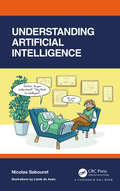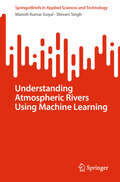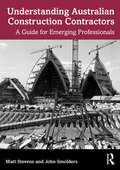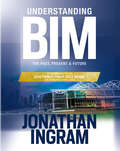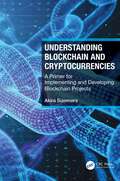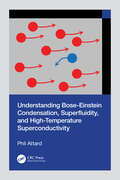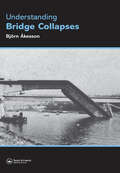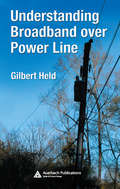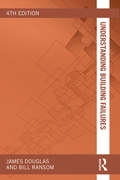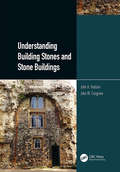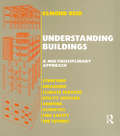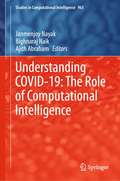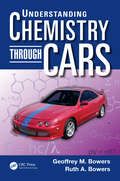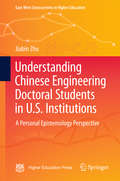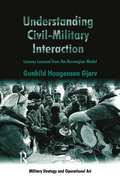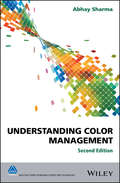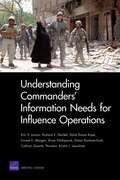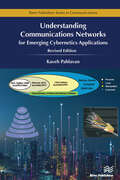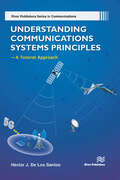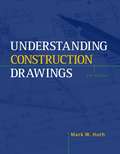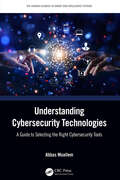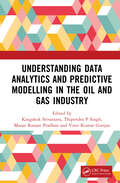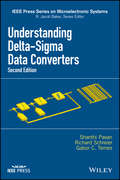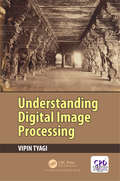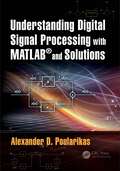- Table View
- List View
Understanding Artificial Intelligence
by Nicolas SabouretArtificial Intelligence (AI) fascinates, challenges and disturbs us. There are many voices in society that predict drastic changes that may come as a consequence of AI – a possible apocalypse or Eden on earth. However, only a few people truly understand what AI is, what it can do and what its limitations are. Understanding Artificial Intelligence explains, through a straightforward narrative and amusing illustrations, how AI works. It is written for a non-specialist reader, adult or adolescent, who is interested in AI but is missing the key to understanding how it works. The author demystifies the creation of the so-called "intelligent" machine and explains the different methods that are used in AI. It presents new possibilities offered by algorithms and the difficulties that researchers, engineers and users face when building and using such algorithms. Each chapter allows the reader to discover a new aspect of AI and to become fully aware of the possibilities offered by this rich field.
Understanding Atmospheric Rivers Using Machine Learning (SpringerBriefs in Applied Sciences and Technology)
by Manish Kumar Goyal Shivam SinghThis book delves into the characterization, impacts, drivers, and predictability of atmospheric rivers (AR). It begins with the historical background and mechanisms governing AR formation, giving insights into the global and regional perspectives of ARs, observing their varying manifestations across different geographical contexts. The book explores the key characteristics of ARs, from their frequency and duration to intensity, unraveling the intricate relationship between atmospheric rivers and precipitation. The book also focus on the intersection of ARs with large-scale climate oscillations, such as El Niño and La Niña events, the North Atlantic Oscillation (NAO), and the Pacific Decadal Oscillation (PDO). The chapters help understand how these climate phenomena influence AR behavior, offering a nuanced perspective on climate modeling and prediction. The book also covers artificial intelligence (AI) applications, from pattern recognition to prediction modeling and early warning systems. A case study on AR prediction using deep learning models exemplifies the practical applications of AI in this domain. The book culminates by underscoring the interdisciplinary nature of AR research and the synergy between atmospheric science, climatology, and artificial intelligence
Understanding Australian Construction Contractors: A Guide for Emerging Professionals
by Matt Stevens John SmoldersThis book will provide emerging construction professionals with insights and information helpful for a successful career in the Australian construction industry. This work fills a critical gap and is written by two authors with decades of experience immersed in current issues. It provides a starting point for the next generation of Australian construction contractors. Beginning with an overview of the industry, the chapters explore winning work, project operations, financial management, people skills and selling a successful business. The authors use case studies to enrich the content and include reviews and commentaries on some of the legendary management books. In addition, readers of the book will find answers to essential industry questions: Why is construction one of the best industries in Australia? What is its most significant conflict? Which are the three most consistently profitable sectors? What are the essential ten questions to answer for standardising practices? Is work acquisition more art or science? Is it a good idea to fire a client? Why? How to identify and address the office - field conflict? What is the job cost format for unifying project stakeholder information? What are the best key performance indicators for a construction contracting firm? What alignments are needed in general hiring and personnel management processes? What is the process in identifying and implementing a best practice? How do you value the market price for a construction firm? This book should be read by anyone entering the built environment sector in Australia. Universities, Colleges and TAFEs can use this book in various construction business and operations management courses. Supporting materials are available through a website.
Understanding BIM: The Past, Present and Future
by Jonathan IngramUnderstanding BIM presents the story of Building Information Modelling, an ever evolving and disruptive technology that has transformed the methodologies of the global construction industry. Written by the 2016 Prince Philip Gold Medal winner, Jonathan Ingram, it provides an in-depth understanding of BIM technologies, the business and organizational issues associated with its implementation, and the profound advantages its effective use can provide to a project team. Ingram, who pioneered the system heralding the BIM revolution, provides unrivalled access to case material and relevance to the current generation of BIM masters. With hundreds of colour images and illustrations showing the breadth and power of BIM, the book covers: The history of BIM What BIM is in technical and practical terms How it changes the day to day working environment Why we need BIM and what problems it can solve Where BIM is headed, particularly with regards to AI, AR, VR and voice recognition International case studies from a range of disciplines including: architecture, construction management, and retail Professionals and students in any field where the inter-disciplinary aspects of BIM are in operation will benefit from Ingram’s insights. This book is an authoritative account of and reference on BIM for anyone wanting to understand its history, theory, application and potential future developments.
Understanding Blockchain and Cryptocurrencies: A Primer for Implementing and Developing Blockchain Projects
by Akira SummersWhether you are a project manager looking to lead blockchain projects, a developer who would like to create blockchain-based applications, or a student with an interest, this book will provide you with the foundational understanding that you need.You have probably noticed that blockchains are growing in popularity. Governments are investigating Digital Currencies, supply chains are adopting Digital Ledgers, games makers and artists are developing NFTs (Non-Fungible Tokens), and new use-cases are emerging regularly.With such growth, many people will find themselves needing to understand how these technologies work. There will be new project teams, with technical leads managing blockchain projects and developers creating distributed applications. This book is great for them as it explains the concepts on which blockchain technologies are based, in simple terms.We will discuss and explain topics such as hashing, Merkle trees, nodes, mining, proof of work and proof of stake, consensus mechanisms encryption, vulnerabilities, and much more. The structures and principles described will be relevant for developers and managers alike, and will be demonstrated through relevant examples throughout the text.If you are looking to understand this exciting new technology, this is the book for you.
Understanding Bose-Einstein Condensation, Superfluidity, and High-Temperature Superconductivity
by Phil AttardBose-Einstein condensation, superfluidity, and superconductivity are quantum mechanics made visible. They mark the boundary between the classical and the quantum worlds, and they show the macroscopic role of quantum mechanics in condensed matter.This book presents these phenomena in terms of particles, their positions, and their momenta, giving a concrete visualisation and description that is not possible with traditional wave functions. A single approach that bridges the classical-quantum divide provides new insight into the role of particle interactions in condensation, the nature of collisions in superfluid flow, and the physical form of Cooper pairs in high-temperature superconductors.High-temperature superconductivity is explored with quantum statistical mechanics, which links it to Bose-Einstein condensation. Identifying a new mechanism for Cooper pairing, this explains the differences between the low- and high-temperature superconducting regimes and the role of the molecular structure of the conductor.The new perspective offered by this book on Bose-Einstein condensation, superfluidity, and high-temperature superconductivity gives particle-based explanations as well as mathematical and computational methods for these macroscopic quantum phenomena so that readers understand the role of particle interactions and structure in the physics of these phenomena.This book will appeal to undergraduate and graduate students, lecturers, academics, and scientific researchers in the fields of Bose-Einstein condensation and condensates, superfluidity, and superconductivity. It will also be of interest to those working with thermodynamics, statistical mechanics, statistical physics, quantum mechanics, molecular dynamics, materials science, condensed matter physics, and theoretical chemistry.Key Features:· Explores Bose-Einstein condensation with new evidence for multiple condensed states and novel Monte Carlo simulations for interacting bosons· Establishes the thermodynamic nature of condensed bosons from an analysis of fountain pressure measurements, including that they carry energy and entropy, and the thermodynamic principle of superfluid flow· Derives equations of motion for condensed bosons, and performs molecular dynamics simulations of the viscosity with molecular trajectories that give rise to superfluidity· Identifies the mechanism for electron pairing in high-temperature superconductivity
Understanding Bridge Collapses
by Björn ÅessonThis book presents a detailed overview of 20 cases of famous and other highly interesting bridge collapses over the last two centuries. Every case is illustrated and described in detail and the failure analyses made are supported by well-known explanations and, in some cases, by new theories. The chronological order makes it easy to follow the gradual development in the use of different bridge types and the choice of construction material. This analysis of the complex phenomena of fatigue and buckling is a critical area for consulting engineers and for advanced-level and postgraduate students in structural and bridge engineering.
Understanding Broadband over Power Line
by Gilbert HeldUnderstanding Broadband over Power Line explores all aspects of the emerging technology that enables electric utilities to provide support for high-speed data communications via their power infrastructure. This book examines the two methods used to connect consumers and businesses to the Internet through the utility infrastructure: the existing ele
Understanding Building Failures (Understanding Construction)
by Bill Ransom James DouglasBuilding defects still continue to plague the construction industry. The lessons learned over the last forty years have not been fully applied. Many new or refurbished buildings still leak or crack. Lack of awareness by designers and installers as to the main mechanisms that trigger such failures remains a problem for the industry. Investigating and rectifying building failures form a major part of building surveyors’ bread and butter work. This book provides guidance on this work for typical residential, commercial and industrial buildings – with advice on how to diagnose a wide range of defects with an emphasis on evidence based practice throughout. It considers both modern and older construction methods, together with new and traditional materials. The particular problems of alteration and renovation work are also discussed. The first four chapters provide information and guidance on the methodology for investigating failures – how to prepare for and conduct an investigation into a building defect and subsequently diagnose its cause in a logical manner. This fourth edition has been updated and expanded to cover the latest diagnostic procedures and research. It also includes Appendices and a new Bibliography, and provides an extensive list of books on building pathology and related topics in the UK and North America. It is essential reading for all students and practitioners interested in building surveying and building conservation.
Understanding Building Stones and Stone Buildings
by John A. Hudson John W. CosgroveThis book covers the wide spectrum of subjects relating to obtaining and using building stones, starting with their geological origin and then describing the nature of granites, volcanics, limestones, sandstones, flint, metamorphic stones, breccias and conglomerates, with emphasis being placed on how to recognise the different stones via the many illustrated examples from Great Britain and other countries. The life of a building stone is explained from its origin in the quarry, through its exposure to the elements when used for a building, to its eventual deterioration. The structure of stone buildings is then discussed, with explanations of the mechanics of pillars, lighthouses and walls, arches, bridges, buttresses and roof vaults, plus castles and cathedrals. The sequence of the historical architectural styles of stone buildings is explained—from the early days through to postmodern buildings. Special attention is paid to two famous architects: the Roman Vitruvius and the English Sir Christopher Wren who designed and supervised the construction of St. Paul’s Cathedral in London. To demonstrate many of the concepts presented, two exemplary stone buildings are described in detail: the Albert Memorial in London and Durham Cathedral in northern England. The former building is interesting because it is comprised of a cornucopia of different building stones and the latter building because of its architecture and sandstone decay mechanisms. In the final Chapter, ruined stone buildings are discussed—the many reasons for their decay and the possibility of their ‘rebirth’ via digital recording of their geometry. The book has over 350 pages and is illustrated with more than 450 diagrams and colour photographs of both the various stones and the associated stone buildings. Readers’ knowledge of the subject will be greatly enhanced by these images and the related explanatory text. A wide-ranging references and bibliography section is also included.
Understanding Buildings a Multidisciplinary Approach: A Multidisciplinary Approach
by E. ReidThis book meets the needs for a basic, yet comprehensive and up-to-date, introductory text to building technology for students in architecture and the other disciplines in building design. The wide coverage is organised under the chapter headings: structure, enclosure, climate services, utility services, lighting, acoustics, fire safety, the future? The treatment in each case is concentrated on the close relationship between good design practice and the basic underlying scientific and practical principles, but stopping short of the high level theory which is to be found in other more closely specialised texts.This well illustrated and highly readable book will be invaluable to the student and of interest to the practitioner too, both in architecture and in its related technical fields.
Understanding COVID-19: The Role of Computational Intelligence (Studies in Computational Intelligence #963)
by Ajith Abraham Janmenjoy Nayak Bighnaraj NaikThis book provides a comprehensive description of the novel coronavirus infection, spread analysis, and related challenges for the effective combat and treatment. With a detailed discussion on the nature of transmission of COVID-19, few other important aspects such as disease symptoms, clinical application of radiomics, image analysis, antibody treatments, risk analysis, drug discovery, emotion and sentiment analysis, virus infection, and fatality prediction are highlighted. The main focus is laid on different issues and futuristic challenges of computational intelligence techniques in solving and identifying the solutions for COVID-19. The book drops radiance on the reasons for the growing profusion and complexity of data in this sector. Further, the book helps to focus on further research challenges and directions of COVID-19 for the practitioners as well as researchers.
Understanding Chemistry through Cars
by Geoffrey M. Bowers Ruth A. BowersAs the car anticipates its dance around the racetrack, the engine growls and pops, and all senses become immersed in the smell of exhaust vapors and the sounds of raw speed and excitement. As it turns out, these also are the sights, sounds, and smells of chemistry! The car is a great example of an everyday device with an abundance of chemistry hidi
Understanding Chinese Engineering Doctoral Students in U.S. Institutions
by Jiabin ZhuThis book uses a mixed-method approach to address the topic of personal epistemology among Chinese engineering doctoral students from U. S. institutions. --It presents a broad view of the epistemological development among Chinese engineering students from five U. S. Midwestern doctoral programs. Meanwhile, it provides practical examples from students' academic experiences to showcase their thinking development and behavioral patterns. It allows readers to gain an understanding of Chinese engineering students' academic lives in U. S. institutions through a cognitive theoretical lens. It also highlights a number of factors that can potentially facilitate adult students' cognitive development, and extends the discussion on the benefits of study-abroad and cross-cultural education to the epistemological domain.
Understanding Civil-Military Interaction: Lessons Learned from the Norwegian Model (Military Strategy and Operational Art)
by Gunhild Hoogensen GjørvA novel examination of civil-military interaction in particular between militaries and humanitarian actors, in light of the so-called 'Norwegian model' that espouses a clear divide between political and humanitarian (or military and civilian - the model is in fact unclear) actors, while maintaining a tight coordination between them. The Norwegian government has significantly reduced their own military's capacity in the field of civil-military interaction, raising the question as to whether knowledge and skills in this field are necessary. Using a multi-actor security framework, this book examines whether or not the Norwegian government is correct in its assumptions (about both the model and civil-military knowledge amongst military personnel) and concludes that the Norwegian model is a well-meaning but inefficient and problematic model in reality. Although the case study focuses on Norway, the lessons learned are relevant to all nations engaged in civil-military operations.
Understanding Color Management (The Wiley-IS&T Series in Imaging Science and Technology)
by Abhay SharmaAn accessible but technically rigorous guide to color management for all users in all market segments Understanding Color Management, 2nd Edition explains the basics of color science as needed to understand color profiling software, color measuring instruments, and software applications, such as Adobe Photoshop and proofing RIPs. It also serves as a practical guide to International Color Consortium (ICC) profiles describing procedures for managing color with digital cameras, LCD displays, inkjet proofers, digital presses and web browsers and tablets. Updates since the first edition include new chapters on iPads, tablets and smartphones; home-cinema projection systems, as well as, with the industrial user in mind, new additional chapters on large-format inkjet for signage and banner printing, flexography, xerography and spot color workflows. Key features: Managing color in digital cameras with Camera Raw and DNG. Step-by-step approach to using color management in Adobe Photoshop CC. M0, M1, M2 instrument measurement modes explained. Testing of low cost, iPhone color measuring instruments. Updated to include iccMAX (Version 5.0) ICC profiles. G7 calibration explained with practical examples. Conventional printing conditions described - SNAP, GRACoL, SWOP, Fogra, CRPC. New sections on Pantone EXTENDED GAMUT Guide. Introduction to XML for color management applications. Understanding Color Management, 2nd Edition is a valuable resource for digital photographers, keen amateurs and end-users, graphic designers and artists, web masters, production and prepress operators and supervisors, color scientists and researchers, color consultants, and manufacturers. It is a must-have course text for college and university students of graphics arts, graphic communications, digital photography, print media, and imaging arts and sciences. The Society for Imaging Science and Technology (imaging.org) is an international professional society whose mission is to keep members and others aware of the latest scientific and technological developments in the greater field of imaging. A major objective of the Wiley-IS&T series is to advance this goal at the professional level. The broad scope of the series focuses on imaging in all its aspects, with particular emphasis on digital printing, electronic imaging, image assessment and reproduction, image archiving and preservation, color science, pre-press technologies, and hybrid imaging systems.
Understanding Commanders' Information Needs for Influence Operations
by Eric V. Larson Brian Nichiporuk Dalia Dassa Kaye Forrest E. Morgan Richard E. DarilekDocuments a study whose goals were to develop an understanding of commanders' information requirements for cultural and other "soft" factors in order to improve the effectiveness of combined arms operations, and to develop practical ways for commanders to integrate information and influence operations activities into combined arms planning/assessment in order to increase the usefulness to ground commanders of such operations.
Understanding Communications Networks – for Emerging Cybernetics Applications
by Kaveh PahlavanInformation networking has emerged as a multidisciplinary diversified area of research over the past few decades. From traditional wired telephony to cellular voice telephony and from wired access to wireless access to the Internet, information networks have profoundly impacted our lifestyles as they have undergone enormous growth. To understand this technology, students need to learn several disciplines and develop an intuitive feeling of how they interact with one another. To achieve this goal, the book describes important networking standards, classifying their underlying technologies in a logical manner and gives detailed examples of successful applications.The emergence of wireless access and dominance of the Ethernet in LAN technologies has shifted the innovations in networking towards the physical layer and characteristics of the medium. This book pays attention to the physical layer while we provide fundamentals of information networking technologies which are used in wired and wireless networks designed for local and wide area operations. The book provides a comprehensive treatment of the wired IEEE802.3 Ethernet, and Internet as well as ITU cellular 2G-6G wireless networks, IEEE 802.11 for Wi-Fi, and IEEE 802.15 for Bluetooth, ZigBee and ultra-wideband (UWB) technologies. The novelty of the book is that it places emphasis on physical communications issues related to formation and transmission of packets and characteristics of the medium for transmission in variety of networks.Material presented in the book will be beneficial for students of Electrical and Computer Engineering, Computer Science, Robotics Engineering, Biomedical Engineering, or other disciplines who are interested in integration of navigation into their multi-disciplinary projects. The book provides examples with supporting MATLAB codes and hands-on projects throughout to improve the ability of the readers to understand and implement variety of algorithms.
Understanding Communications Systems Principles—A Tutorial Approach
by Héctor J. SantosWireless communications and sensing systems are nowadays ubiquitous; cell phones and automotive radars typifying two of the most familiar examples. This book introduces the field by addressing its fundamental principles, proceeding from its very beginnings, up to today's emerging technologies related to the fifth-generation wireless systems (5G), Multi-Input Multiple Output (MIMO) connectivity, and Aerospace/Electronic Warfare Radar. The tone is tutorial. Problems are included at the end of each chapter to facilitate the understanding and assimilation of the material to electrical engineering undergraduate/graduate students and beginning and non-specialist professionals. Free temporary access to Keysight's SystemVue system simulation is provided to further enhance reader learning through hands-on tutorial exercises.Chapter 1 introduces wireless communications and sensing and in particular how curiosity-driven scientific research led to the foundation of the field. Chapter 2 presents a brief introduction to the building blocks that make up wireless systems. Chapter 3 focuses on developing an understanding of the performance parameters that characterize a wireless system. Chapter 4 deals with circuit topologies for modulation and detection. In chapter 5 we cover the fundamental transmitter and receiver systems architectures that enable the transmission of information at precise frequencies and their reception from among a rather large multitude of other signals present in space. Chapter 6 introduces 5G, its motivation, and its development and adoption challenges for providing unprecedented levels of highest speed wireless connectivity. Chapter 7 takes on the topic of MIMO, its justification and its various architectures. Chapter 8 addresses the topic of aerospace/electronic warfare radar and finally Chapter 9 presents three Tutorials utilizing the SystemVue simulation tool.
Understanding Construction Drawings (5th Edition)
by Mark W. HuthUpdated to the 2006 International Building and Residential Codes, the fifth edition of UNDERSTANDING CONSTRUCTION DRAWINGS continues to highlight a range of real construction projects - from residential dwellings to commercial structures. This enhanced edition combines information and a hands-on approach to learning. The text provides thorough coverage that builds the foundation for a broad understanding of the entire construction process. The book begins with a simple duplex home that focuses readers on the fundamentals of views, lines, basic dimensioning, and symbols. Next, coverage of a multi-level single family home goes into more depth in orienting and cross-referencing drawings. The third section explores multifamily construction and is accompanied by more complex drawings for practice and more advanced interpretations. The final portion of the book introduces students to elements of commercial construction, including structural steel, masonry, and reinforced concrete. An extensive set of drawings packaged with the book illustrates each building so that students can apply important skills and gain a "real-world" understanding of construction drawings in an engaging way.
Understanding Cybersecurity Technologies: A Guide to Selecting the Right Cybersecurity Tools (The Human Element in Smart and Intelligent Systems)
by Abbas MoallemCyberattacks on enterprises, government institutions, and individuals are exponentially growing. At the same time, the number of companies, both small and large, offering all types of solutions has been increasing too. Since companies rely on technological solutions to protect themselves against cyberattacks, understanding and selecting the right solutions among those offered presents a significant challenge for professionals, company executives, and newcomers to the cybersecurity field.FEATURES Presents descriptions for each type of cybersecurity technology and their specifications Explains applications, usages, and offers case studies to enhance comprehension Offers an easy-to-understand classification of existing cybersecurity technologies Provides an understanding of the technologies without getting lost in technical details Focuses on existing technologies used in different solutions, without focusing on the companies that offer these technologies This book is intended to help all professionals new to cybersecurity, students, and experts to learn or educate their audiences on the foundations of the available solutions.
Understanding Data Analytics and Predictive Modelling in the Oil and Gas Industry
by Kingshuk Srivastava, Thipendra P Singh, Manas Ranjan Pradhan and Vinit Kumar GunjanThis book covers aspects of data science and predictive analytics used in the oil and gas industry by looking into the challenges of data processing and data modelling unique to this industry. It includes upstream management, intelligent/digital wells, value chain integration, crude basket forecasting, and so forth. It further discusses theoretical, methodological, well-established, and validated empirical work dealing with various related topics. Special focus has been given to experimental topics with various case studies. Features: Provides an understanding of the basics of IT technologies applied in the oil and gas sector Includes deep comparison between different artificial intelligence techniques Analyzes different simulators in the oil and gas sector as well as discussion of AI applications Focuses on in-depth experimental and applied topics Details different case studies for upstream and downstream This book is aimed at professionals and graduate students in petroleum engineering, upstream industry, data analytics, and digital transformation process in oil and gas.
Understanding Delta-Sigma Data Converters (Second Edition)
by Gabor C. Temes Richard Schreier Shanthi PavanThis new edition introduces operation and design techniques for Sigma-Delta converters in physical and conceptual terms, and includes chapters which explore developments in the field over the last decade Includes information on MASH architectures, digital-to-analog converter (DAC) mismatch and mismatch shaping Investigates new topics including continuous-time ΔΣ analog-to-digital converters (ADCs) principles and designs, circuit design for both continuous-time and discrete-time ΔΣ ADCs, decimation and interpolation filters, and incremental ADCs Provides emphasis on practical design issues for industry professionals
Understanding Digital Image Processing
by Vipin TyagiThis book introduces the fundamental concepts of modern digital image processing. It aims to help the students, scientists, and practitioners to understand the concepts through clear explanations, illustrations and examples. The discussion of the general concepts is supplemented with examples from applications and ready-to-use implementations of concepts in MATLAB®. Program code of some important concepts in programming language 'C' is provided. To explain the concepts, MATLAB® functions are used throughout the book. MATLAB® Version 9.3 (R2017b), Image Acquisition Toolbox Version 5.3 (R2017b), Image Processing Toolbox, Version 10.1 (R2017b) have been used to create the book material. Meant for students and practicing engineers, this book provides a clear, comprehensive and up-to-date introduction to Digital Image Processing in a pragmatic manner.
Understanding Digital Signal Processing with MATLAB and Solutions (The Electrical Engineering and Applied Signal Processing Series)
by Alexander D. PoularikasThe book discusses receiving signals that most electrical engineers detect and study. The vast majority of signals could never be detected due to random additive signals, known as noise, that distorts them or completely overshadows them. Such examples include an audio signal of the pilot communicating with the ground over the engine noise or a bioengineer listening for a fetus’ heartbeat over the mother’s. The text presents the methods for extracting the desired signals from the noise. Each new development includes examples and exercises that use MATLAB to provide the answer in graphic forms for the reader's comprehension and understanding.
